|
+Die Cast Part Design Class
.: a Symposium for Product Designers
and Mechanical Engineers :.
Course Duration:
16 hour workshop
Tuition: $1000 USD
Overview: The course material for this
die casting part design workshop is designed to provide a working knowledge
of the die cast molding industry. The bulk of the time in this workshop
will be spent on the part design requirements imposed on the designer
by the die casting process and the CAD design tool of choice. This class
is for those engineers or industrial designers looking to further their
manufacturing processes experience and understanding of die casting.
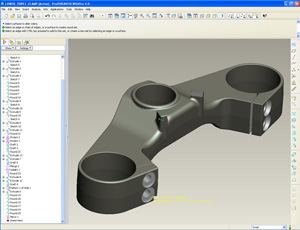 Triple
clamp Pro/ENGINEER model converted to the Diecast process from a machined
from billet model. Triple
clamp Pro/ENGINEER model converted to the Diecast process from a machined
from billet model.
Prerequisites: General knowledge of Pro/ENGINEER
or another parametric 3-dimensional CAD modeler helpful but not necessary.
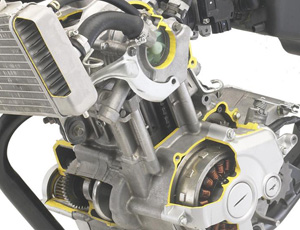
Cut away view of a Yamaha motor showing multiple die cast parts in an
assembly.
Topics:
- The process, die cast molds, tooling, processing factors, Nominal Walls,
- Radii and draft angles, Ribs, Weldlines, stress, cooling metals, bosses,
undercuts.
- Also snap fit, FEA, Design recommendations, overview of flow mold analysis
software.
- Learn to Design molded undercuts and sliders
- Learn about various die cast materials and alloys and discuss material
properties such as adding zinc and copper for more malleable alloys i.e.
Kohler faucets
- Engineers or designers will learn to utilize tooling and die cast molders
as a resource to design better piece parts.
- Learn about the metal mold itself and many of its intricacies such as
sleeve ejection, how it is cooled, sprue and runner, ejector bars, ejector
plates, and ejector pins.
- Discuss the steps for die the casting process
- Learn about the pore-free casting process for eliminating gas porosity.
- Learn about heated-manifold direct-injection die casting.
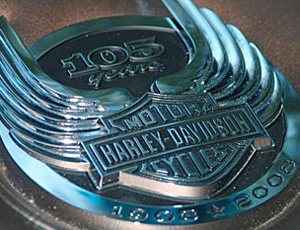
A Harley Davidson Zink Die Cast stylized emblem showing example of a chrome
A side surface.
Discussions:
- History of forming metals
- Die casting as a process and it's specific history
- Discuss how a die cast mold process works in detail hot chamber vs.
cold chamber.
- Learn about Alloys with respect to die casting ... zinc, aluminum, magnesium,
copper, lead, and tin. Also factors in choosing the proper alloy.
- Discuss how China plays a major role in die cast tooling and the casting
process. Discuss the quotation process for tooling and discuss partnering
with local die casters molders vs. outsourcing. - strengths and weakness
of outsourcing.
- Discuss basic design elements in die cast part design. Holes, ribs,
thin wall features, bosses, nominal wall, and fill.
- General rules for hollow boss design and discuss best practices. - Learn
about thin blade situations and discuss ways to avoid.
- Advantages and disadvantages of die casting.
- Discuss gating and discuss problems such as fill vent and eject issues
as related to die casting. Also discuss how to design in solutions to
would be cosmetic problems.
- Discuss cooling time as related to thick sections of aluminum. Discuss
internal voids and fundamentals of other problems that occur from improper
piece part design.
- Discuss using parametric modelers in general and discuss examples where
using variables with a parametric modeler can save problems in the future
complete with in class examples.
- FEA and stress associated with die cast design with respect to FEA.
Keeping in mind the deliverable for FEA is simply to make design recommendations
discuss the possible solutions to many of the common molding problems.
Keep in mind shrink, stress from sharp corners as related to cavity filling.
- List die cast vendors and discuss their role and how designers can leverage
their experience.
- Learn about tooling and different materials for mold design. Discuss
from a machining point of view and compare to cutting graphite for electrode
burning of steel.
- Discuss how to improve flow of the melt through the mold and learn about
Flow Molding analysis software
Discuss designing undercuts and discuss advantages and disadvantages as
relative to costs
- Discuss general disclaimers on drawings such as "brake all sharp
corners" and other associated notes that engineers might find on
detail drawings.
- Discuss different types of undercuts and side pull options
- Discuss what challenges a mold designer faces when designing a mold
with respect to cooling.
- Draft as related to texture kits. Discuss how to call out textures in
drawing programs with examples. Learn about the texture application process
and why die cast parts often recess the texture
.- Learn about Heat treatment and anodizing processes.
- Discuss chrome applications and other plating, painting or powder coating
processes.
-Learn of benefits of joining the North American Die Casting Association.
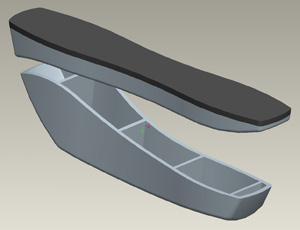 Die
Cast Aluminum Pro/E model. In this Pro/ENGINEER tutorial the user will
create ribs that are offset from the parting line instead of what is shown.
This is also a Copy Geometry tutorial all a part of this die cast part
design class. Die
Cast Aluminum Pro/E model. In this Pro/ENGINEER tutorial the user will
create ribs that are offset from the parting line instead of what is shown.
This is also a Copy Geometry tutorial all a part of this die cast part
design class.
 The
complete diecast stapler where the participants utilize many forms of
sweeps, draft, top down design and draft analysis tools. The
complete diecast stapler where the participants utilize many forms of
sweeps, draft, top down design and draft analysis tools.
Pro/ENGINEER specific:
- Discuss draft in it's many forms complete with examples of split draft
etc.
- Learn to use surfacing and discuss it's usefulness with die cast part
design.
- Learn to use top down design with examples in Pro/ENGINEER.
- Adding draft to parts that currently have no draft.
- on at least one example use Pro/ENGINEER to modify parts that others
modeled so that those parts are moldable.
- Discuss tips tricks and techniques for starting and completing die cast
parts using Pro/ENGINEER.
- Learn to use parameters to drive geometry relative to nominal wall thickness.
- Discuss B-Side geometry creation techniques including secondary operations.
Discuss bosses and ribs.
- Learn to use Utilize Draft check correctly
- Techniques for managing the Pro/E machining features.
- Techniques for mounting your existing die cast part to your CNC machine
(features in Pro/ENGINEER)
There is a great deal of HTML course material students take back with
them from this workshop.
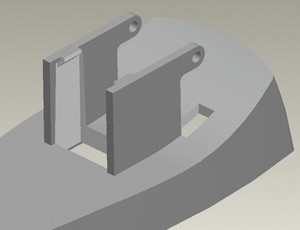
Pro/ENGINEER tutorial that shares modeling technique for creating
shut off geometry.
Compare:
- Compare Metal injection molding or Powder Injection Molding or PIM to
die casting
- Die casting vs. plastic molding
- Die casting vs. permanent mold
- Die casting vs. forging process with respect to cost and quantity.
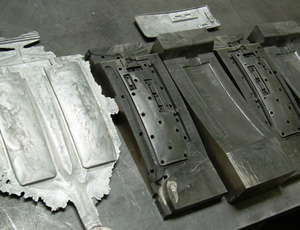
Die Cast parts from a dual cavity mold. Notice the flash, runners and
gate.
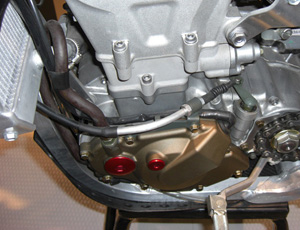
Die Cast parts some analyzed shown in this assembly of a Kawasaki 440
motorcross bike.
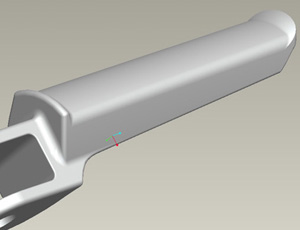
Die Cast Pro/ENGINEER model of a motorcycle foot peg utilizes unique modeling
technique.

|